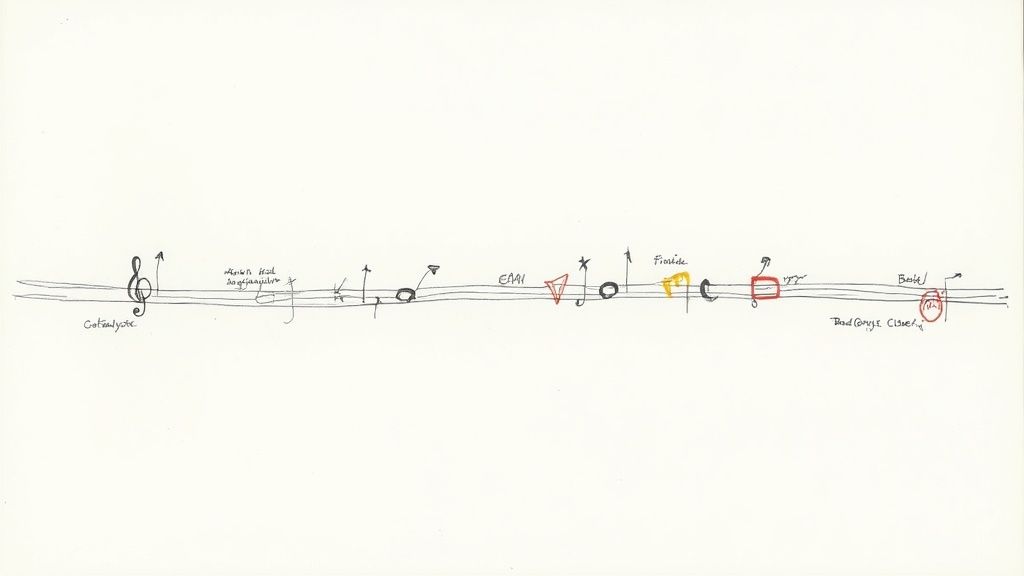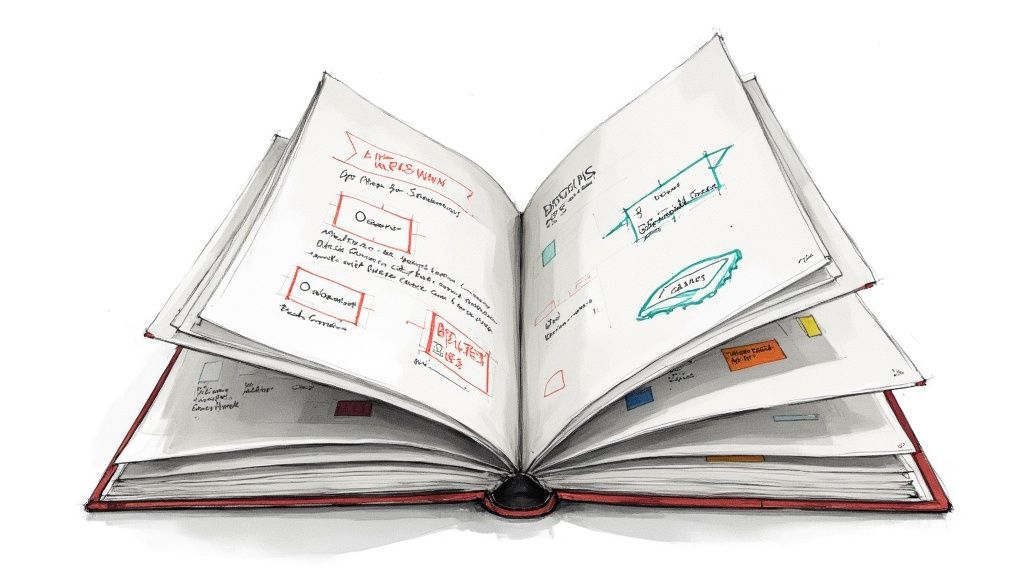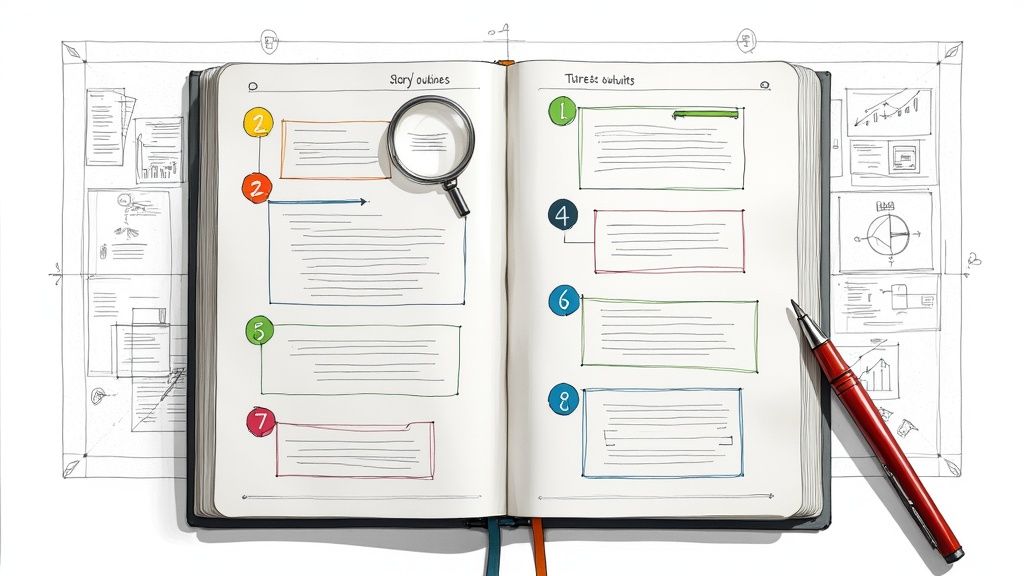6 Complete Novel Outline Example Templates for 2025

Every great novel begins with a solid plan. A well-crafted outline is the architectural blueprint for your story, providing the structure needed to build compelling characters, escalating tension, and a satisfying conclusion without getting lost in the dreaded 'saggy middle.' But staring at a blank page can be daunting. With so many methods, which one is right for your book and your writing process?
This guide moves beyond theory to provide concrete, actionable templates. We will dissect six proven novel outline examples, offering a behind-the-scenes look at how story structure works in practice. You won't just see a list; you'll get a strategic breakdown of each framework, from the classic Three-Act Structure to the intricate Snowflake Method. We'll explore each one with detailed analysis, tactical insights, and replicable strategies you can apply immediately.
Think of this as your personal workshop for story architecture. By examining a complete novel outline example for each method, you'll gain the clarity to select and adapt the perfect framework for your project. By the end, you'll have a clear understanding of how to transform a promising idea into a meticulously plotted manuscript ready for your readers. Let's build your story, beat by beat.
1. Novel Outline Example #1: The Three-Act Structure
The three-act structure is arguably the most recognizable and enduring storytelling framework in Western literature and cinema. Its elegant simplicity provides a robust scaffold for nearly any story, making it an ideal starting point for planners and "pantsers" alike. This structure divides a narrative into three distinct parts: the Setup (Act I), the Confrontation (Act II), and the Resolution (Act III).
This classic framework excels at building and releasing tension. It introduces the world and characters, systematically raises the stakes through escalating conflict, and delivers a satisfying conclusion. For writers seeking a time-tested method to ensure their plot has a clear beginning, a meaty middle, and an impactful end, the three-act structure is unparalleled.
Strategic Breakdown
A powerful novel outline example using this structure can be broken down into key plot points that anchor the narrative's momentum.
- Act I: The Setup. This act establishes the protagonist's ordinary world, introduces the core conflict via the Inciting Incident, and ends with the protagonist committing to the journey at the First Plot Point. It comprises roughly 25% of the story.
- Act II: The Confrontation. The longest section (about 50%), Act II is where the protagonist faces rising obstacles. It contains the Midpoint, a moment of revelation or major shift, and culminates in the Second Plot Point, an all-is-lost moment that forces the protagonist toward the final confrontation.
- Act III: The Resolution. The final 25% is dedicated to the climax and its aftermath. The protagonist faces the antagonist head-on in the Climax, and the story concludes with the Falling Action and Resolution, showing the new normal.
Actionable Takeaways
To effectively implement this structure, focus on the turning points.
Key Tactic: Your plot points at the end of Act I and Act II should be irreversible decisions made by the protagonist. These choices must lock them into the next phase of their journey, eliminating any possibility of turning back to their old life.
Many successful novels and films, from Star Wars to The Hunger Games, are built on this framework. By outlining your story with these key milestones, you create a narrative engine that propels the reader forward. This structure provides clarity and ensures your story’s pacing feels both natural and compelling, making it a foundational tool for any writer's toolkit.
2. Hero's Journey Outline (Monomyth)
The Hero's Journey, or Monomyth, is a powerful archetypal narrative pattern identified by mythologist Joseph Campbell. This structure charts a protagonist’s adventure, their decisive crisis, and their triumphant return home, transformed. It’s a deeply resonant framework that taps into universal human experiences of growth, trial, and transformation, making it a cornerstone of epic fantasy, science fiction, and adventure stories.

This structure is ideal for character-centric tales where the protagonist's internal evolution is just as important as their external quest. It provides a detailed map for a character's psychological and spiritual development. While its 17-stage (or Christopher Vogler’s streamlined 12-stage) version might seem complex, it offers a rich and flexible guide for crafting stories with profound thematic depth.
Strategic Breakdown
A classic novel outline example using the Hero's Journey focuses on three overarching phases: the Departure, the Initiation, and the Return. Each phase contains critical turning points.
- Departure (The Ordinary World): This phase introduces the hero in their normal life, presents the Call to Adventure, and sees them cross the First Threshold into the unknown, often with the help of a Mentor. This is where the quest begins.
- Initiation (The Special World): The hero faces a series of Tests, Allies, and Enemies. This leads to the central crisis or The Ordeal, where they confront their greatest fear. After surviving, they gain The Reward (a special weapon, new insight, etc.).
- The Return (Back to the Ordinary World): The hero journeys back on The Road Back, faces a final test in The Resurrection to prove their transformation, and returns home with The Elixir- a boon or wisdom to share with their community.
Actionable Takeaways
To use this structure effectively, focus on the hero’s transformation at each key stage.
Key Tactic: The "Ordeal" and "Resurrection" are the emotional and thematic core of your story. The Ordeal should be a symbolic death for the hero’s old self, while the Resurrection is the proof that they have truly been reborn as a new, more capable individual.
Great epics like The Hobbit and modern classics such as the Harry Potter series and Star Wars masterfully employ this journey. By mapping your character’s arc to these archetypal stages, you can create a narrative that feels both timeless and deeply personal, ensuring your hero's journey hooks the reader from the very first page. If you want to dive deeper into crafting compelling story openings, you can learn more about how to create viral book hooks on manuscriptreport.com. This structure isn’t just a plot formula; it's a guide to creating a meaningful human experience.
3. Novel Outline Example #3: The Save the Cat! Beat Sheet
Originally developed for screenwriting by Blake Snyder, the Save the Cat! Beat Sheet has been enthusiastically adopted by novelists for its granular, beat-by-beat approach to story structure. It expands the three-act framework into 15 specific story beats, acting as a detailed roadmap that ensures emotional engagement, flawless pacing, and a story that delivers on its core promise.
This method is beloved for its focus on making the protagonist likable early on (the titular "save the cat" moment) and for providing clear percentage markers for where each beat should land. For writers who crave more specific guidance than the broader three-act structure provides, the Save the Cat! method offers a meticulously plotted path from the opening image to the final one.

Strategic Breakdown
A highly effective novel outline example using this model breaks the narrative into precise, emotionally resonant moments. The structure is still rooted in three acts but is fleshed out with greater detail.
- Act I Beats (1% - 25%). This includes the Opening Image, Theme Stated, Setup, Catalyst (the inciting incident), and the Debate section where the hero hesitates before crossing the threshold in the Break into Two beat.
- Act II Beats (25% - 75%). The second act is defined by the B Story (often a subplot introducing a key relationship), the Fun and Games section where the story delivers on its premise, a crucial Midpoint that raises the stakes, Bad Guys Close In as opposition mounts, an All Is Lost moment, and the Dark Night of the Soul where the hero hits rock bottom.
- Act III Beats (75% - 100%). The final act begins as the hero finds a new solution in the Break into Three beat, leading to the Finale where they confront the central conflict. The story wraps up with a Final Image that mirrors the opening, showing how much the protagonist has changed.
Actionable Takeaways
To leverage the Save the Cat! structure, focus on the emotional and logistical purpose of each beat.
Key Tactic: Don't skip the smaller beats. The Debate section, for example, is critical for making your protagonist's final decision to act feel earned and realistic. Likewise, the B Story provides an emotional anchor and often holds the key to the story's theme.
This beat sheet is the secret weapon behind commercial hits like The Hunger Games and Ready Player One, where every story turn feels perfectly timed to maximize reader investment. By planning your novel around these 15 beats, you create a story with a powerful commercial hook and a deeply satisfying character arc, making it a go-to framework for genre fiction writers.
4. Novel Outline Example #4: The Seven-Point Story Structure
For writers who prefer a plot that is inextricably linked to character development, the Seven-Point Story Structure offers a powerful and intuitive framework. Developed by author Dan Wells, this method encourages you to start with the ending and work backward, creating a mirror-like structure that ensures every plot turn directly impacts the protagonist's internal arc.
This structure is particularly effective for creating tightly woven narratives where the character's growth feels earned and central to the story's resolution. It excels at building a symmetrical plot that progresses logically from a character's initial state to their final, transformed self. If you want to ensure your plot and character arcs are perfectly in sync, this structure provides a clear, actionable roadmap.
Strategic Breakdown
A highly effective novel outline example using this method centers on seven key beats that connect external plot events with internal character shifts.
- The Hook: The protagonist’s starting point. This is their world and their primary flaw or problem before the story truly begins.
- Plot Point 1: The event that pushes the character into the main conflict, often representing a call to adventure. This moves them from their ordinary world into a reactive state.
- Pinch Point 1: The first real application of antagonistic force. The villain or conflict makes its power known, pressuring the protagonist.
- The Midpoint: A crucial turning point where the protagonist shifts from reacting to the conflict to proactively seeking a solution. They now understand the true nature of the stakes.
- Pinch Point 2: Another, stronger application of the antagonistic force. This moment raises the stakes and reminds the reader of the villain's capabilities, often hitting closer to home for the protagonist.
- Plot Point 2: The "all is lost" moment. The protagonist gains the final piece of knowledge or the tool they need to solve the conflict, but it comes at a great cost, leaving them at their lowest point.
- The Resolution: The climax and conclusion. The protagonist, now fully changed, confronts the conflict using what they learned at Plot Point 2 and achieves their goal. This is the mirror opposite of the Hook.
Actionable Takeaways
To master this structure, focus on the symmetry between the beginning, middle, and end.
Key Tactic: Define your Resolution first. Know exactly how your protagonist will solve the final conflict and what their transformed self looks like. Then, create a Hook that is the polar opposite of that resolution. This immediately establishes a clear and compelling character arc for your entire story.
This method is a favorite of many genre authors, including Brandon Sanderson and Jim Butcher. By framing your story around these seven points, you build a narrative where every major event serves the dual purpose of advancing the plot and evolving the character. This creates a deeply resonant and satisfying reading experience, making it an excellent tool for crafting character-driven fiction. Learn more about the Seven-Point Story Structure and other outlines for a deeper dive.
5. Novel Outline Example #5: The Snowflake Method
The Snowflake Method, developed by author Randy Ingermanson, is a unique, fractal-based approach to story design. It starts with a single, core idea and expands it layer by layer, much like a snowflake crystallizes from a central point. This method is perfect for writers who want a structured process that builds both plot and character simultaneously from the ground up.

This iterative system provides a powerful sense of direction, preventing writers from getting lost in the weeds of an overly complex plot. It ensures that every scene and character detail is connected to the central theme of the story. It’s particularly useful for intricate genres like epic fantasy or science fiction, where complex world-building and multiple character arcs need to be managed meticulously.
Strategic Breakdown
A detailed novel outline example using the Snowflake Method involves a ten-step process that grows in complexity. Each step builds upon the last, ensuring a cohesive and deeply developed narrative.
- Steps 1-3: Core Foundation. This begins with a one-sentence summary of your novel. This sentence is then expanded into a one-paragraph summary that introduces the setup, major disasters, and ending. Finally, you write a one-page summary for each main character, detailing their motivations, goals, and conflicts.
- Steps 4-6: Plot Expansion. You take each sentence from your one-paragraph summary and expand it into its own full paragraph, creating a one-page synopsis. Then, you develop one-page character descriptions for all major characters and a half-page for minor ones. Finally, you expand your one-page synopsis into a four-page synopsis, fleshing out the plot details.
- Steps 7-10: Scene Creation. With a solid foundation, you expand your detailed character charts and create a list of all scenes needed to tell the story. From this list, you begin writing the first draft, often by writing out longer descriptions of each scene, which can be organized with a book chapter summary template.
Actionable Takeaways
To use the Snowflake Method effectively, embrace its iterative nature and trust the process to build momentum.
Key Tactic: Don't move to the next step until the current one is solid. Each step is a foundation for the next. If your one-sentence summary is weak, your entire story will be. Revise earlier steps as new ideas emerge in later ones.
The power of this method lies in its systematic approach. It forces you to make key decisions about your story’s conflict and character arcs early on, ensuring every element you add serves the core narrative. By building your story from a single sentence to a full scene list, you create a deeply integrated and logically sound plot, making it a fantastic tool for writers who thrive on structure and planning.
6. Novel Outline Example #6: The Fichtean Curve
The Fichtean Curve is a narrative structure built for relentless momentum and escalating tension. Named after the German philosopher Johann Gottlieb Fichte’s concept of thesis-antithesis-synthesis, this structure plunges the reader directly into rising action, bypassing a lengthy setup. The story unfolds as a series of crises, each more intense than the last, creating a continuous state of suspense that pulls the reader forward.
This framework is the engine behind many modern thrillers and suspense novels. It excels at creating a page-turning experience by focusing on conflict and character reaction. For writers who want their story to grab the reader from the first page and never let go, the Fichtean Curve offers a powerful blueprint for maintaining high-stakes energy from beginning to end.
Strategic Breakdown
An effective novel outline example using the Fichtean Curve organizes the plot around three core components that replace traditional acts.
- The Rising Action. This is the bulk of the story. It begins almost immediately, introducing the protagonist amidst an unfolding crisis. The narrative then progresses through a chain of subsequent crises, with each event raising the stakes, revealing character, and complicating the protagonist’s situation. There are only brief moments of respite, or "sequels," between these high-tension scenes.
- The Climax. Unlike structures where the climax appears at the end of Act III, the Fichtean Curve places its climax around the two-thirds or three-quarters mark. This is the story’s peak of conflict, the point where the central struggle is met head-on and the main dramatic question is answered.
- The Falling Action. Following the intense climax, this final section is dedicated to exploring the consequences. It resolves subplots and shows the protagonist and their world in the aftermath of the main conflict, establishing a new status quo. This part is often longer and more detailed than in other structures.
Actionable Takeaways
To master this structure, your focus must be on the strategic escalation of conflict.
Key Tactic: Ensure each crisis is a direct consequence of the protagonist's attempt to solve the previous one. This creates a tight, causal chain of events where the character’s own actions propel them deeper into trouble, making the rising tension feel earned and inescapable.
Novels like Suzanne Collins' The Hunger Games and many of Dan Brown's thrillers utilize this model to keep readers hooked. By mapping out a series of interconnected crises, you build a narrative that is less about a slow burn and more about a controlled explosion, making it an exceptional tool for crafting gripping, high-concept stories.
6 Popular Novel Outline Methods Compared
| Story Structure | 🔄 Implementation Complexity | 💡 Resource Requirements | 📊 Expected Outcomes | 💡 Ideal Use Cases | ⭐ Key Advantages |
|---|---|---|---|---|---|
| Three-Act Structure Outline | Moderate; clear, linear acts with set plot points | Low to moderate; requires act planning and pacing | Clear beginning-middle-end, satisfying resolution | All genres, especially traditional stories | Universally understood; easy for new writers; industry standard |
| Hero's Journey Outline | High; 17 stages with archetypal roles and cyclical path | Moderate; deep character and thematic development | Rich character arcs and transformational impact | Fantasy, adventure, epic journeys | Deep emotional resonance; proven success in major franchises |
| Save the Cat! Beat Sheet | Moderate; 15 specific timed beats with strong pacing rules | Moderate; detailed beat planning needed | High reader engagement, strong pacing, page-turners | Commercial fiction, thrillers, fast-paced plots | Specific, actionable guidelines; prevents sagging middles |
| Seven-Point Story Structure | High; backward planning from resolution with plot & character points | High; requires detailed upfront plotting | Tight, cohesive narrative with escalating stakes | Mystery, thriller, tightly plotted novels | Strong story cohesion; balances plot and character growth |
| Snowflake Method | High; iterative 10-step expansion from summary to detailed outline | High; intensive planning & step completion | Detailed, well-developed plot and characters | Writers needing detailed planning, complex stories | Flexible growth; excellent character development tools |
| Fichtean Curve | Moderate to high; continuous escalating crises, no traditional acts | Moderate; requires crafting multiple crises | Sustained tension and momentum, page-turning pacing | Thrillers, action, suspense-heavy novels | Maintains constant tension; eliminates saggy middle |
Choosing Your Blueprint and Building Your Story
We've explored a diverse array of narrative blueprints, from the classical symmetry of the Three-Act Structure to the character-driven expansion of the Snowflake Method. Each novel outline example serves as a powerful testament to the fact that structure isn't a restriction on creativity; it is the very framework that gives it shape, momentum, and emotional resonance. Your story's unique needs will determine which framework, or combination of frameworks, works best.
The core lesson is one of adaptation. These outlines are not rigid, unbreakable laws. They are flexible guides, battle-tested systems designed to help you navigate the complexities of plot, character arc, and pacing. Think of them as your architectural toolkit. You wouldn't build a sleek sci-fi thriller with the same blueprint as a sprawling fantasy epic, and your outlining process should reflect that strategic choice.
Key Takeaways: From Theory to Action
The true power of any novel outline example lies not in memorizing its beats but in understanding the why behind them. Why does the "All Is Lost" moment in Save the Cat! hit so hard? Because it's a structural guarantee that the hero's victory will be earned. Why does the Fichtean Curve delay the inciting incident? To build a deep, simmering tension that hooks the reader from the first page.
Your next steps should be grounded in this strategic mindset:
- Identify Your Core Story: Before picking an outline, articulate your story's central conflict and your protagonist's emotional journey. This will immediately suggest which structure is the most natural fit.
- Create a Hybrid Model: Don't be afraid to mix and match. You might use the Seven-Point Story Structure for your main plot but apply the Hero's Journey to your protagonist's internal arc. The goal is a custom blueprint tailored to your narrative.
- Focus on a "North Star" Beat: Pinpoint the most critical moment in your story, whether it's the Midpoint reversal, the Climax, or the a key Pinch Point. Build your outline around ensuring that single moment lands with maximum impact.
- Treat Your Outline as a Living Document: Your outline is a map, but sometimes you discover a more scenic route during the writing process. Allow yourself the freedom to revise and refine your outline as your story evolves and your characters reveal new depths.
Ultimately, a well-crafted outline is your first and most powerful strategic asset. It provides clarity, prevents plot holes, and ensures every scene serves a purpose. By mastering these structural concepts, you move from simply telling a story to engineering an unforgettable reader experience. You are building a foundation that will support your narrative from the first word to the final, satisfying conclusion. The real journey of writing begins now, with a clear path forward.
Ready to see how your carefully crafted outline translates into a marketable masterpiece? Upload your manuscript to ManuscriptReport.com for an instant analysis of your story's structure, tropes, and commercial appeal. Get the data-driven insights you need to position your novel for success at ManuscriptReport.com.
Related Articles

6 Book Blurb Examples: Proven Styles That Sell in 2025
6 proven book blurb examples from bestsellers with formulas you can copy. Hook Opening, Character-Driven, Stakes-Driven styles that boost sales 30%+.

7 Story Outline Examples: Which Structure Will Make Your Book Sell?
Stop wasting time on the wrong outline. Compare 7 proven story structures side-by-side with ROI analysis to choose the framework that matches your genre and goals.